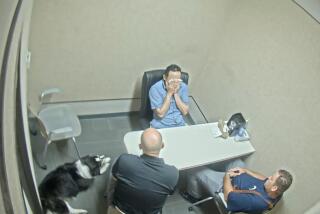Felon slain by CHP officer after allegedly killing woman in Fontana
The Fontana police chief and San Bernardino County’s chief probation officer said a convicted felon who allegedly stabbed a woman to death at a Fontana park-and-ride exposed flaws in Gov. Jerry Brown’s controversial plan to give local governments responsibility for nonviolent prisoners.
David Mulder, 43, a transient with a long history of drug-related convictions, was shot and killed Sunday night by a California Highway Patrol officer responding to a report of a woman being attacked in a car near the San Bernardino Freeway. The woman, Elisa VanCleve, 49, of Rialto, was in the car with Mulder and died of multiple stab wounds.
Mulder had been released from state prison Sept. 25 under the governor’s realignment program that transferred supervision of prisoners convicted of nonviolent and non-sex-related crimes from the state to local agencies.
Just a week before the slaying, another felon released under the program allegedly raped a woman in a Fontana motel room, according to the Fontana Police Department. Juan Francisco Aguilera, 30, had previous convictions for grand theft auto, drug possession, receiving stolen property and robbery.
Fontana Police Chief Rod Jones called both cases prime examples of the failure of realignment.
“Dangerous prisoners that belong in state prison continue to be released early, time and time again, to return to our communities and endanger our families and friends,” Jones said. “Had Mulder remained incarcerated, on either recent occasion, for his full sentence, this woman would still be alive.”
San Bernardino County’s Chief Probation Officer Michelle Scray Brown said Mulder was among those prisoners being released who are “simply not appropriate for community supervision.”
Though his crimes were nonviolent, Mulder has been sent to state prison eight times since 1990, primarily for drug possession convictions, but had a history of violating his parole and skirting probation officers.
“When these kinds of things happen, it’s horrible. We ask ourselves, did we supervise him to the best of our ability? And the answer is yes, we arrested this guy several times for violations”’ Brown said. “Clearly this guy was a high risk to the community.”
Brown said her agency has hired more than 100 additional probation officers since the governor’s prison reforms went into effect, stationing them at every police department throughout the massive county.
Over the last 18 months, 37% of those supervised by county probation officers have committed other crimes or violated terms of their release, compared with more than 80% of those who had been supervised by state parole officers in the county, according to the county agency.
“These people are being supervised,” Brown said. “The bottom line is that there are just some people who are going to continue to commit crimes regardless of who is supervising them.”
A spokesman for the state Department of Corrections and Rehabilitation said blaming realignment for Mulder’s release was both misguided and inaccurate. Mulder had finished his prison sentence and would have been released to San Bernardino County, where he was originally sentenced, regardless.
“The guy served his prison time and we had no authority to hold him beyond that. Whether he was on parole or probation, he still would have been in their county,” said agency spokesman Luis Patino. “We have to remember that the Supreme Court of the United States ordered that we lower our [prison] population. The other options were worse. We couldn’t just have opened the gates and let everybody back.”
After his release from state prison in September, Mulder enrolled in a sober-living facility in Upland. In December, a visiting county probation officer found that Mulder had disappeared and failed to report a change of address. Mulder was arrested March 25, and three days later a San Bernardino County judge sentenced him to 30 days in county jail for violating the terms of his probation, giving him credit for 11 days of time already served.
Mulder was released from jail a week later, April 1. Because he said he was homeless, the probation department placed a GPS electronic monitoring device on him.
San Bernardino County Sheriff’s Department spokeswoman Jodi Miller said Mulder was released from custody April 1 because of the 14 days of “good and work time” credits he received based on the state’s sentencing guidelines.
Chris Condon, spokesman for the probation agency, said it’s not surprising that Mulder would have been released early because the county jails are filled with inmates who, in previous years, would be doing their time in state prison.
“Our jails have been repurposed to be used as state prisons, and we do not have sufficient bed space to house this population,” Condon said.
ALSO:
UCLA water polo player accused of rape wants to attend class
Fillmore fire: Winds subside; firefighters try to regain advantage
Social media suspected in vandalism at Joshua Tree National Park
Twitter: @philwillon
phil.willon@latimes.com
More to Read
Sign up for Essential California
The most important California stories and recommendations in your inbox every morning.
You may occasionally receive promotional content from the Los Angeles Times.










